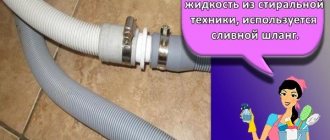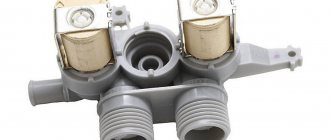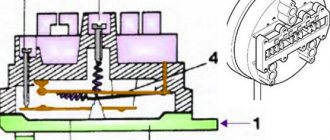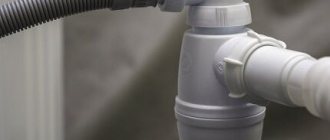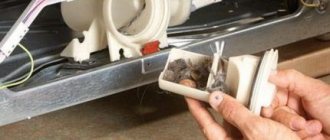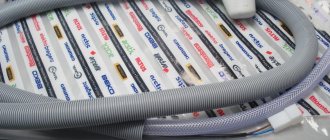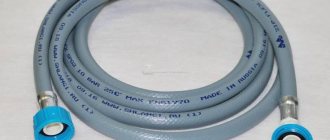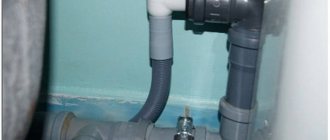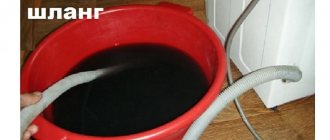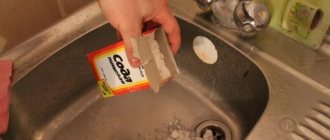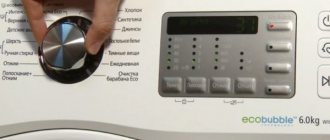Drain hose for washing machine and its types
The drain hose (sleeve) performs one task - it drains dirty water after washing and rinsing things into the sewer. If your equipment is not equipped with a device for discharging waste water, or you want to replace the drain hose for your washing machine, the price will range from 30 to 1300 rubles. The final cost will depend on the length of the drain and the specific model of household appliances.
There are three types of drainage devices offered on the plumbing market:
- Standard drain hose.
Its length ranges from 1 to 5 meters. If necessary, it can be extended with a second similar one using a plumbing clamp.
- Telescopic drain hose.
It has become widespread due to the fact that it fits almost all modern car models. Its length when folded is 60 cm. When stretched, this figure reaches two meters. Disadvantages of this type of drain hoses:
- high vibration during draining;
- clogged more often;
- Cracks and tears may appear.
- Drain hose in a reel.
The length of the coil from the manufacturer is 50 meters. It consists of modules soldered together. You just need to measure the required length and cut along the notch. The length of a single module is 50-55 centimeters. The neck is usually made of steel. Using a very long hose of this type not only leads to the appearance of stagnant areas of dirty water, but even blocks the drain. In addition, such a tube is easier to damage or deform.
Drain hoses are made of polypropylene, painted gray. There are special connectors at the ends (19 and 22 mm). The drain hose from the washing machine is connected to the sewer. If the tube cannot be connected to a drain, secure it to the sink or bathtub.
Some exceptions
There are situations when the drain hose for a washing machine, even three meters long, does not reach the toilet, sink or shower stall.
We have to increase it to the maximum values. What “relaxations” are allowed here? Experts say that Zanussi washing machines have a pump with enough power to pump dirty water over a distance of up to eight meters without any problems. In general, most of the brands common on our market can handle lengths of up to 4.5 meters without much difficulty. So, connecting the drain hose of the washing machine can be done without any fear.
What should be the length of the washing machine drain hose?
Think about how you will drain from the machine to the waste pipe. Use a tape measure to measure this distance. The drain hose is available at all stores selling household goods and household appliances.
These stores sell hoses of different lengths: from 1 to 5 meters, as well as modular drain hoses.
As we have already said, modular hoses are sold in large coils and consist of 0.5 meter segments. All you have to do is contact the seller so that he can measure and cut the sleeve to the required length.
However, modular hoses are not always easy to find, so we advise you to opt for other types of hoses.
So, you came to the store to buy a drain hose for your washing machine. How to do this correctly? Remember that when choosing a drainage device, you should not be guided by the principle - “You don’t have enough stock in your pocket!” and buy the longest hose. The shorter the length, the easier it is for the drain pump to pump water from the washing machine to the drain. If possible, install the automatic machine so that the distance to the drain does not exceed 3.5 meters.
Types of washing machine hoses
Typically the following types of hoses are distinguished:
1) Standard. This type comes with a fixed length from 1 to 5 meters. To extend, several tubes are connected together.
2) Telescopic. It has a length of up to 2 meters when stretched and a diameter of up to 60 cm. Sold assembled and compressed. During the flow of water, it vibrates strongly and clogs occur with it. You should not forget about this disadvantage when choosing. In addition, it can tear if stretched too hard.
3) Hose in a coil. Quite convenient and practical to use. It has serifs for setting the length yourself. The hose is usually up to 50 cm. But it is not recommended to use it as a drain. The risk of blockages is also high.
4) Drain pipe. Quite versatile. Made from polypropylene. Removes contaminated liquids well. It has fittings with a diameter of 19 or 22 cm at the ends. Fittings can have the same or different diameters at the ends of the pipe. This makes it easier to connect to the washing machine and sewer system.
Remember! When choosing a drain hose, pay attention not only to the length and diameter, but also to the type of hose.
Types of drain hose models
- – Connected to the siphon. Installation occurs through a threaded connection.
- – Connected to a separate outlet on the sewer pipe through sealing collars.
- – Without connection to sewerage. They have a bend at the end for attaching to a bathtub, sink or toilet for flushing water there.
Important! The third type of hose is inconvenient, but indispensable if the sewer network is in poor condition.
Diameters of hoses and sewer pipes
The diameter of the sewer pipe to which the hose is attached is usually 40,50, 90 or 110 mm. The wall thickness of PET pipes is about 3 mm, and their diameter is smaller. With a diameter of 40-50 mm, the wall thickness is usually also 3 mm, and with 90-110 mm, the thickness is 5 mm.
The internal diameters of washing machine hoses range from 16 to 63 mm. Most manufacturers have an internal diameter of the drain hose of 19 mm and an external diameter of 22 mm. There are also 25 mm in diameter, for example some LG models.
The ends of the hose have fittings for mounting with a diameter of 19mm or 22mm. On older Indesit machines, a diameter of 29 mm is used, but this size is quite rare on other washing machines.
Major manufacturers of drain hoses
- The Russian company Helfer produces hoses that can withstand pressures of up to 10 Bar and temperatures of up to 60 degrees. Fittings 19 mm.
- The Italian Nylonflex produces high-strength hoses that can withstand pressures of up to 10 Bar and temperature changes from -5 to +70 degrees.
- Italian TSL hoses can withstand pressure of 5 Bar and have fittings 19*22 mm. Suitable for Ariston, Electrolux, Zanussi, Bosch and Whirlpool washing machines.
- produces corrugated hoses with operating temperatures from -5 to +60 degrees, maximum pressure 3 Bar, footage up to 50 m and diameter from 16 to 63 mm.
The Russian company TuboFlex produces hoses that can withstand pressures of up to 2 bar, with a length of 1.5 to 3.5 meters. Suitable for Indesit, Atlant, Samsung and Beko washing machines.
How to install a washing machine drain hose
If you still need a longer hose, then buy two hoses and use a connector. As a rule, this is a short plastic tube; the ends of the drains are placed on it and tightened with clamps.
In a situation where the diameter of the washing machine drain hose is different from the diameter of the extension, try to connect the end extending from the washing machine with the end of the tube that has a larger value of this indicator, using a plumbing adapter with different numerical parameters at the ends - 19 and 22 millimeters. When connecting hoses of identical diameter, use a standard 22 by 22 mm connector.
You can easily make such an adapter yourself from a rigid PVC tube of the required size. It will be no different from what is sold in stores. Tighten the hoses onto the connector with clamps.
To start washing, an automatic machine needs water, which enters the tank of the technical device from the central water supply. There are also alternative ways of delivering it to start the cycle. At the end of the wash, the used liquid is removed using a special device, which, as a rule, is supplied with the device. Connecting the washing machine drain hose is a common procedure. There are two ways to organize the removal of dirty water from the tank:
- Temporary,
using a special plastic bracket included with the machine. The drain is attached to the edge of the sink or bathtub.
- Stationary
, connecting to the drain directly with a tie-in. The plastic guide is needed here to prevent the drain hose from kinking, which can block the drain.
Washing machine users often prefer the second installation option. With this method of connecting the washing machine drain hose, it is invisible and does not spoil the overall appearance of the bathroom. It completely eliminates the situation when the hose is simply not secured to the edge of the sink or bathtub, and after the end of the wash cycle, dirty water drains to the floor.
Follow the recommendations of specialists before installing the drain hose for your washing machine yourself. How to attach? What is the height of the washing machine drain hose? Does your washing machine have a drain hose check valve? All these points are very important, and compliance with installation standards will help prevent possible breakdowns of expensive equipment.
- The check valve installed on modern models of washing machines allows water to flow in one direction. If it is not there, you need to maintain a certain height for securing the drain device. Typically, the permissible height at which the drain is installed is indicated in the operating manual of the automatic machine. Failure to follow the recommendation may result in damage.
- A washing machine drain hose extension is used when the existing hose is not of sufficient size and it is problematic to bring its end to the sewer outlet. However, as in the case of buying a tube that is too long, the same principle applies here: if it is too long, the sump pump will work harder and may not cope with its task, which will also lead to its breakdown and costly repairs.
- Regardless of how you secure the drain - temporarily or permanently, its end should not be immersed in water.
Read material on the topic: How to open an online store for plumbing fixtures
How to connect the drain hose?
Using a plastic guide, the drain hose is attached to the edge of an acrylic bathtub or sink. You can use a siphon from the washbasin as a drain, or buy a special double siphon with an additional outlet for the drain hose of the washing machine. If you do not have enough length of the hose to drain the water, then this situation can be easily corrected. You need to purchase a plastic extension, another drain hose and two clamps. The hose coming from the washing machine is inserted into the plastic extension, and the second hose is inserted into the other side of the extension. Both hoses are secured with clamps. That's it, the extended hose can be connected to the sewer.
Replacing the drain hose is easier than replacing the fill hose. This is due to the fact that in order to get to the base of the drain hose, you need to slightly disassemble the washing machine and climb inside it. Some brands of washing machines have a drain hose attached at the top of the body, and some at the bottom. To find out what the connection is in your washing machine, you need to remove the cover of the washing machine. Although for some brands, for example, AEG, Siemens and Bosch, it is necessary to remove the front part of the case .
However, let’s focus on replacing the drain hose through the back of the case, as is done with the brands Indesit, Ariston, LG, Candy, Ardo, Beko, Samsung, Whirpool. For these models, the drain hose is located at the bottom of the rear housing cover. After removing the panel (this is done easily):
- unscrew the screws and the cover itself can be easily removed;
- slowly remove the drain pump filter, having prepared a rag and bucket in advance;
- Pour water out of the washing machine, first placing a bucket and tilting it forward;
- Remove the volute , whose bolts are previously unscrewed. It is best to take a photo of how the clamp was secured so that you know how to attach a new one;
- Loosen the clamp securing the hose to the pump and disconnect the hose. We pull it and take it out of the washing machine;
- Install the new hose and secure it with a clamp in the same way as the previous drain hose was attached.
- Install the volute and screw the other parts with self-tapping screws, as it was before replacing the hose. Before replacing the rear panel cover, you need to make sure that the new hose connection is tight .
- Using a screwdriver tighten the self-tapping screw and replace the rear panel cover.
Replacing the drain hose is done completely differently in models where the hose is located on the front panel.
We take out the dispenser container. Then we remove the base panel, loosen the clamp securing the door cuff, and detach the cuff from the door wall. Then the drain pump filter is removed (you also need to prepare a rag and a bucket first). After the residual water has drained out, the front part of the panel is removed. To do this, screw the screws using a screwdriver. The bottom of the panel wall must be moved towards you until a gap of 5 cm is formed. We put our hand there and by touch we look for the hatch locking device. We detach the connector with wires from it. After that, pull the panel towards you and remove it.
We had access to the drain hose. The fixing elements are removed from it, and the hose is disconnected from the pump. We remember the location of the hose and fasteners. Disconnect and remove the hose. We connect the new hose, secure it and assemble the machine, having first checked the tightness of the connection of the hose to the pump.
Top-loading washing machines have a drain hose located on the side. To replace it, you need to do all the steps that were described in previous cases, only you remove not the back or front panel, but the side one.
How to connect the drain hose to a washing machine via a siphon
To drain dirty water through the siphon located under the sink, you need to replace the existing one with a special one for an automatic machine. Such siphons have the necessary pipes to which wastewater is supplied, including a drain hose for a washing machine. Place the siphon at a sufficient height to form a water seal, preventing the penetration of sewerage smell into the room and the reverse flow of water.
Install the purchased siphon, tighten the connections. Check the assembly for reliability by running water. Then connect the drainage device to the pipe using a plumbing coupling and a rubber collar that prevents the connection from leaking and prevents odors from the sewer from entering the room. Or take a special adapter for the drain hose of the washing machine, tighten the connection with a clamp to make it tight.
Organizing the drain using a siphon (stationary connection) will not interfere with taking a bath or washing your face using the sink during laundry. If the water is drained into the sink or bathtub, then this possibility is eliminated, since the bathtub will fill with dirty water after the end of the wash cycle. Washing in a sink into which used liquid is drained will also not be very pleasant.
Please note that the siphon must be installed strictly vertically. Horizontal installation is unacceptable, as this method risks leaks. The height of the drainage organization is also important. The bend of the special plastic bracket in which the drainage device is fixed must be at least 60 centimeters from the floor level.
Another interesting solution related to connecting a drain to a siphon is siphons for hidden installation in the wall. One side is used for connection to sewer pipes, the other for supplying drain hoses. The contacts are also sealed using a clamp or cuff. An outlet is installed in the immediate vicinity to connect to a cold water source. With this solution, the connection process (even when replacing the old washing machine with a new one) will take no more than 5-10 minutes.
What types of inlet hoses are there?
Hoses for water supply can be made of rubber, polypropylene, rubber. These are quite reliable, durable and at the same time flexible materials. In addition, the hose for a washing machine can be two-layered, in which, in addition to the main rubber layer, there is another one - a protective one. It is made of nylon or metal fibers/threads that are intertwined. This further strengthens the tube and protects it from both internal influences (water pressure) and external, but minor ones.
Despite the good strength characteristics, it is better to protect the inlet hose as much as possible from external factors. Taking these measures will extend the life of the filling device by preventing accidental damage to it. After all, if you spoil the hose, you can cause a flood, which you are unlikely to be happy about.
Filling hoses presented in stores come in several types:
- ready-made with a fixed length;
- sold by the meter, they are supplied in “coils”;
- with Aquastop leak protection system.
Ready-made ones are available in lengths from one to five meters. They are good because they only need to be connected to the machine and the ball valve. The ends of these hoses are already reinforced with metal sleeves and equipped with a fastening nut. Since the nuts are made of plastic, they can only be screwed to the faucet and washing machine by hand. Using a wrench for this may damage the fastening and render the inlet hose unusable.
If the inlet hose is damaged during installation or in any other way, it is not worth disassembling and repairing it. It is better to buy a new one that is fully functional, and throw away the old one without regret. An attempt to repair an old one is fraught with leaks in its further use.
If a ready-made hose for a washing machine does not have the required length, you can purchase it by the meter from a “coil”. True, you will have to install sleeves and nuts on it yourself, which is not entirely convenient. There is also a risk of making connections that are not airtight. Therefore, it is better to install the washing machine no further than 5 meters from the connection tap. If this is not possible, then it is better to bring the supply line closer to the car using pipes.
Also, the length of the hose can be increased by connecting several hoses into one. There are special connectors for this. Using this solution to connect the machine, additionally seal the hose connection points with FUM tape. This will ensure better sealing of the connection, which will protect against leaks.
How to connect the drain hose of a washing machine to the sewer without a siphon
Draining is not difficult to do directly, without a siphon. You will need a sewer tee and a rubber collar to seal the connection. The device must be inserted into the section of the sewer pipe and the drain must be connected to its outlet through the cuff. It is possible to connect the sewer drain pipe to the washing machine and connect it directly to the hose. Create a bend in the hose in front of the sewer pipe, protecting the machine tank from the sewer system. This insulates against unpleasant odors. Seal the connection.
If the drain is left straight, without an S-curve or rise, odors from the drain can easily enter the washing machine drum where the washed, clean clothes lie. Instead of bending, it is better to use the same siphon, which is guaranteed to cut off any “flavors”. And to prevent wastewater from accidentally getting back into the tank, use an anti-siphon - a check valve.
General recommendations for connection
To be able to connect the machine to the cold water supply, a tee must be cut into the pipe, onto which a special ball valve must then be installed to connect the washing machine. When this condition is met, the inlet hose is connected with the straight end to the tap and the curved end to the machine. By additionally installing a coarse filter in front of the ball valve, you will protect your washing equipment from the ingress of rust particles, which are present in abundance in water supply pipes. In principle, the standard filter quite reliably protects the car from large particles. It is installed at the water inlet of the washing machine and consists of a small mesh.
When connecting the machine to the water supply, try as much as possible to avoid a long route for laying the inlet hose. This will eliminate the need to connect multiple hoses, thereby reducing the risk of leakage. Also, a long water supply device may become twisted, especially if it is not secured. If the distance from the machine to the connection point cannot be reduced, then the best option in this situation would be to use polypropylene pipes. Use them to move the faucet closer to the machine.
Screw the inlet hose carefully without overtightening the fastening nuts. Using excessive force or tools (wrench, pliers) may cause the hose fastener to burst. When tightening the fastening nuts, do not allow them to become distorted. Because this way it will not be possible to ensure a tight fit and, accordingly, a tight connection.
How to extend the drain hose of a washing machine
Together with the new washing machine, the manufacturer provides all the necessary accessories for connecting it to the water supply and sewerage system. However, the standard package does not take into account the individual layout of your home and does not always meet the buyer’s requirements. The most common problem of this kind is a short drain hose.
The standard length of the drainage device that comes with the machine is 2 meters. If it is not enough, you can use a washing machine drain hose extension, which can be purchased separately at a plumbing store. In addition to this device, you will also need a connector and metal clamps, through which you will ensure the necessary tightness.
There are several ways to extend the drain hose to the required length:
- If an adapter is used for extension, it can be a thin-walled rigid PVC tube with an external size of no more than 20 millimeters and metal clamps of a suitable diameter - no more than 27 millimeters to seal the connection.
- To perform a “hidden” installation of a drainage system (when the extension cord needs to be hidden in a wall or in a floor screed), a plastic pipe up to 3.5 meters long and 20 millimeters in diameter is best suited.
- Another practical and simple option for extending the drain is a compact telescopic tube. It will provide a reliable sealed connection without bending or folding.
- You can also use regular corrugation of standard length - up to 2 meters.
Remember the important rule regarding maximum drain length? That's right, its size should not be more than 3.5 meters! If you cannot limit yourself to this length, then it is better to move the machine closer to the drain than to add additional meters of hose.
Before you begin the seemingly simple process of sleeve extensions, familiarize yourself with the standard recommendations. Consistent implementation of the points of this recommendation will allow you to avoid offensive mistakes and guarantee a good result.
Algorithm for performing the work:
- Before starting work, make sure that all the necessary materials are available, and, if necessary, purchase the missing accessories. If there is no pipe of the required diameter on sale, then buy one whose diameter is as close as possible to the one you already have and use an adapter.
- Disconnect the machine from the power supply. Place the ends of the existing drain hose and extension onto the connector; the contact point is indicated by a special mark made exactly in the middle of the tube.
- Create a tight, airtight connection using clamps. Do not over-tighten the clamps; you may damage the tube.
Before using the machine for the first time, check again how well the joints are sealed. If necessary, seal the ends of the hoses with a special sealant. Inspect the place where the drain hose is installed, make sure there are no objects with sharp edges or protruding interior features that could cause it to rub or be damaged.
Read material on the topic: Engineering plumbing wholesale: range and prices
How to do it?
Having talked about some of the nuances of the process, it would be ridiculous not to talk about how all this is done. First of all, you will need an extension hose, the diameter of which must completely match that attached to the machine itself.
The new drain hose for the washing machine is connected to the old one using a special adapter. For reliability, it is tightened with clamps. All this can be purchased at home appliance stores, or you can select pieces of water pipe of a suitable diameter and buy clamps in the garage.
Please note that the extension hose of the washing machine should not rise to a height of more than a meter, as otherwise the load on the pump may be too large.
Replacing the washing machine drain hose without problems
Models of automatic equipment differ from each other, therefore, the location of the drain hose in them also differs. But there are universal rules on how to change the drain hose in a washing machine that apply to all types.
- If the wash cycle was turned on, wait until the program completes and make sure the washing machine drum stops completely. Unplug the machine. Secure the wire in the grooves on the back wall of the washing machine so that it does not interfere with your work later.
- Disconnect the water supply hose from the water supply system. When unscrewing it, be careful not to lose the sealing rubber ring. Unfasten the drain hose from the sewer pipe and close the sewer outlet with a special plug. Attach the drain and supply tubes to the back of the washing machine so that the free ends point upward. The preparation stage is completed.
- How to remove the drain hose from a washing machine? The drain tube comes out of the bottom or top of the back wall of the machine, but to remove it, we need to get to the pump. Lift the top cover of the machine. You will see that the sleeve is connected to the pump. Disconnect it from the pump and from the machine body and carefully remove it. Pay attention to the shape of the old device. Sometimes manufacturers use an L-shaped drain hose for the washing machine. The bend, as a rule, is located in the area of the pump, that is, inside the machine itself. You may have difficulty finding and purchasing an identical sleeve. If you can't find a replacement, don't despair, use L-shaped ends, which are exactly what you'll find at a plumbing store, and a standard drain hose.
- Pour out the remaining water from the hose. Proceed to install the purchased drain in reverse order. Carefully follow the manufacturer's instructions in the instructions.
What are the hose sizes?
All hoses for draining waste water from a washing machine or dishwasher can be divided into three groups:
- ordinary, having a fixed length from 1 to 5 meters;
- The coiled hose is long, sold by the meter, and divided into modules for ease of cutting. This means that you can cut a hose from it to any desired length. However, to connect to the washing machine, the length of the drain hose must be limited, because a long hose creates additional load on the pump;
- telescopic hose - a corrugated tube, which in a compressed state has a length of 0.6 m, and in an extended position 2 m. The disadvantages of this hose are that it is more susceptible to blockages, vibrates more strongly when draining, and can be torn if stretched sharply.
Drainage hoses are made of gray polypropylene, roughly speaking, plastic. Special fittings made of elastic rubber are connected to the end of the hose. When we talk about hose diameter, we mean the internal diameter of the fittings. Fittings of the following sizes can be installed on hoses:
- both fittings are 19 mm;
- one fitting is 19 mm, the other is 22 mm;
- both fittings are 22 mm.
It is extremely rare in washing machines to find a hose with a fitting for connecting to a pump with a diameter of 29 mm, for example, on old Indesit machines.
How to clean the drain hose in a washing machine
Often, a washing machine malfunction is caused by dirt in the drain hose. It becomes clogged during operation of the equipment. A suspension of dirty soapy water settles inside, containing fabric fibers, wool, and hair.
You can clean the drain hose of your washing machine. Let's look at how to implement this below.
To clean, the drain hose is completely disconnected from the washing machine. The sequence of actions depends on the model of the device and the method of attaching the hose to the water drainage system.
Record your actions using photos or videos; this will help you avoid confusion during assembly and will be useful for subsequent repairs.
First, unplug the washing machine from the electrical outlet. Shut off the water supply pipe. Drain any remaining water from the drum through the drain filter. Disconnect the hose from the sewer system; if there is water left in the drain hose of the washing machine, drain it.
To detach the other end of the sleeve, you will need a set of screwdrivers and pliers.
Let's consider the circuit for disconnecting drain hoses for washing machines LG, Indesit, Ardo, Ariston, Samsung, Candy, Beko, Whirrool:
- Detach the bottom panel by unscrewing the screws with a screwdriver (some models may have a bolted or missing bottom).
- Remove the bolts holding the filter.
- Place the washing machine on the side wall, having first laid something under it (this will protect the floor and the device itself from scratches). Before doing this, screw the shipping bolts holding the washing machine drum into the corresponding holes on the back wall.
- Unclench the clamp with pliers. Disconnect the drain hose from the pump and washing machine body.
To disconnect the drain hoses for Zanussi and Electrolux washing machines, the rear wall is disconnected. You need to do the following:
- Release the latches holding the drain hose;
- Unscrew the hose supplying water to the washing machine;
- Unscrew the bolts securing the top cover and remove it;
- Unscrew the bolts holding the wall and remove it;
- Using pliers, loosen the clamp on the drain hose and disconnect it from the drainage system.
The design solution of German-made washing machines involves disconnecting the drain hoses for Bosch, AEG, Siemens washing machines after removing the front part of the case:
- Remove the detergent tray from the housing;
- Separate the bottom panel of the case;
- Remove the clamp securing the cuff;
- Detach the cuff;
- Unscrew the bolts securing the front wall;
- Unscrew the bolts securing the lock of the locking mechanism or carefully move the wall, reach out and disconnect the cable leading to the lock;
- Lift the front wall up a little and pull it towards you to remove it from the hooks;
- Loosen the clamp and carefully remove the drain hose.
All methods discussed apply to front-loading washing machines.
On top-loading machines, the drain is disconnected through the side wall. For this:
- Unscrew the bolts holding the side wall;
- Remove the panel;
- Unclench the clamp and pull out the drain hose.
The drain hose is cleaned with a thin Kevlar cable (synthetic fiber). A small brush at the end of such a cable will remove dirty soap deposits from the inner walls of the sleeve. To do this, perform the following algorithm:
- Pass the cable through the hose several times at both ends;
- Remove the cable and place one of the holes in the hose under running water;
- Secure the drain in its original place;
- Reassemble the washing machine by performing the steps in reverse order.
To improve the result, pour any anti-scale agent or citric acid into the washing powder tray and run the wash cycle at 60°C.
To prevent blockages in the drain, it is recommended:
- Using a special laundry bag;
- Adding water softeners along with detergent;
- Carrying out preventive descaling;
- Using washing powder for automatic washing machines;
- Checking clothing pockets for small items.
Read material on the topic: Wholesale sale of polypropylene pipes at competitive prices
Replacing the hose
Each washing machine model is individual, that is, the drain is attached in different ways. But there are basic rules, regardless of the brand of washing machine:
- First you need to turn off the power. The cord must be secured to the back of the washing machine so that it does not get in the way during work.
- Next, the water supply is turned off. When disconnecting the hose, the main thing is not to lose the gasket that is located in this tube. In the place where the drain was attached, you need to install a plug, and attach the hose directly to the back of the washing machine with the pipe facing the top.
- To replace the hose, access to the internal elements of the machine is required. As a rule, the hose is attached near the pump. For ease of work, you need to unscrew the top roof of the housing. The hose most often protrudes from the top or bottom of the back of the washer. To replace it, you need to unscrew it from the pump and housing.
- The hose is then disconnected from the sewer system. Now we begin to install the new product. All washing machine models do this in different ways, so it is recommended to study the instructions.
The maximum hose length is most often standard, especially when it comes to diameter. If any of the fittings of the washing machine are non-standard, then you need to specially order a hose or increase the length. Something you can easily handle with your own hands.
Types of supply hoses
Hoses for connecting machines to water supply systems are supplied to the domestic market in the following sizes:
- Fixed. The length of such a product is up to 500 cm. Usually, the washing machines come with supply elements up to 150 cm in length.
- In coils longer than 500 cm. In the store, you can ask the seller to cut the product to any length or purchase the entire coil.
- Telescopic. Their design resembles a sewer corrugation. This allows you to change the size of the product within certain limits.
A separate type of water supply hoses are supply products with active protection Aqua Stop. Conventional tubes may leak during operation. Its untimely detection can lead to damage to furniture and finishing not only in your apartment, but also in the neighbors downstairs.
Typically, inlet hoses are supplied with plumbing fixtures. However, their length is not always enough
The Aqua Stop system prevents such situations. This is achieved by a special design. It consists of two pipes of different diameters. In this case, one is placed in the other, and a special substance is placed between them, which swells when wet, blocking the leak that appears.
More expensive models of supply elements are also equipped with a pump. If for any reason the first Aqua Stop protective mechanism does not work, an electric pump comes to the rescue, pumping out the leaked water into the sewer, preventing it from flowing out.
Tubes for supplying water to the washing machine can also be classified by manufacturer. The most popular companies involved in their production are:
- CODO. Produces two-layer hoses with an integrated Aqua Stop system. They are allowed to operate at a liquid temperature of no more than 250°C and an operating pressure of up to 20 Bar.
- Aquastop. The product is equipped with the Aqua Stop protective mechanism. The maximum pressure at which the product retains its initial parameters is 90 Bar. This is more than enough for the domestic water supply.
- UDI-Black. Manufactures supply tubes that can be used at temperatures above 500 °C. Moreover, their throughput reaches 40 l/min.
- Aqualine. Is a domestic manufacturer of hoses. Despite the lack of active protection against leakage in the products of this company, it copes well with its assigned functions and is characterized by low cost.
READ ALSO: How to remove a red wine stain
